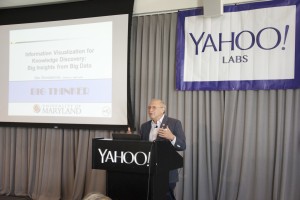 Last week we were honored to have had Dr. Ben Shneiderman, Professor of Computer Science and Founding Director of the Human-Computer Interaction Laboratory at the University of Maryland, present a Big Thinkers talk at Yahoo entitled, "Information Visualization for Knowledge Discovery: Big Insights from Big Data." During his presentation, Dr. Shneiderman focused on the importance of visualization tools in answering Big Data questions and solving Big Data problems. Shneiderman enthusiastically stated that "visualization is a way of engaging people," and that "visualizations give you answers to questions you didn't know you had."
Professor Shneiderman also covered his "8 Golden Rules of Data Science":
Last week we were honored to have had Dr. Ben Shneiderman, Professor of Computer Science and Founding Director of the Human-Computer Interaction Laboratory at the University of Maryland, present a Big Thinkers talk at Yahoo entitled, "Information Visualization for Knowledge Discovery: Big Insights from Big Data." During his presentation, Dr. Shneiderman focused on the importance of visualization tools in answering Big Data questions and solving Big Data problems. Shneiderman enthusiastically stated that "visualization is a way of engaging people," and that "visualizations give you answers to questions you didn't know you had."
Professor Shneiderman also covered his "8 Golden Rules of Data Science":
- Choose actionable problems and compelling theories
- Open your mind: domain experts and statisticians
- If you don't have questions, you're not ready
- Clean, clean, clean... your data (gently on the screen)
- Know thy data: ranges, patterns, clusters, gaps, outliers, missing values, uncertainty
- Evaluate your efficacy, refine your theory
- Take responsibility, reveal your failures
- Work is complex, proceed with humility
The event was broadcast live on our
labs.yahoo.com homepage and viewers had the opportunity to ask questions and comment on our Twitter stream
@YahooLabs as well as our
Facebook page.
You can view Dr. Shneiderman's full presentation here:
ABSTRACT
Interactive information visualization tools provide researchers with remarkable capabilities to support discovery from Big Data resources. Users can begin with an overview, zoom in on areas of interest, filter out unwanted items, and then click for details-on-demand. The Big Data initiatives and commercial success stories such as Spotfire and Tableau, plus widespread use by prominent sites such as
The New York Times have made visualization a key technology.
The central theme is the integration of statistics with visualization as applied for time series data, temporal event sequences such as electronic health records (
www.cs.umd.edu/hcil/eventflow), and social network data (
www.codeplex.com/nodexl). By temporal pattern search & replace and network motif simplification, complex data streams can be analyzed to find meaningful patterns and important exceptions. The talk closes with 8 Golden Rules for Big Data.
BIOGRAPHICAL NOTE
Ben Shneiderman (
http://www.cs.umd.edu/~ben) is a Distinguished University Professor in the Department of Computer Science and Founding Director (1983-2000) of the Human-Computer Interaction Laboratory (
http://www.cs.umd.edu/hcil/) at the University of Maryland. He is a Fellow of the AAAS, ACM, and IEEE, and a Member of the National Academy of Engineering, in recognition of his pioneering contributions to human-computer interaction and information visualization. His contributions include the direct manipulation concept, clickable web-link, touchscreen keyboards, dynamic query sliders for Spotfire, development of treemaps, innovative network visualization strategies for NodeXL, and temporal event sequence analysis for electronic health records.
Ben is the co-author with Catherine Plaisant of
Designing the User Interface: Strategies for Effective Human-Computer Interaction (5th ed., 2010)
http://www.awl.com/DTUI/. With Stu Card and Jock Mackinlay, he co-authored
Readings in Information Visualization: Using Vision to Think (1999). His book
Leonardo’s Laptop appeared in October 2002 (MIT Press) and won the IEEE book award for Distinguished Literary Contribution. His latest book, with Derek Hansen and Marc Smith, is
Analyzing Social Media Networks with NodeXL (
www.codeplex.com/nodexl, 2010).
YAHOO LABS BIG THINKERS SPEAKER SERIES
Yahoo Labs is proud to bring you its 2014 Big Thinkers Speaker Series. Each year, some of the most influential, accomplished experts from the research community visit our campus to share their insights on topics that are significant to Yahoo. These distinctive speakers are shaping the future of the new sciences underlying the Web and are guaranteed to inform, enlighten, and inspire.
 Last week we were honored to have had Dr. Ben Shneiderman, Professor of Computer Science and Founding Director of the Human-Computer Interaction Laboratory at the University of Maryland, present a Big Thinkers talk at Yahoo entitled, "Information Visualization for Knowledge Discovery: Big Insights from Big Data." During his presentation, Dr. Shneiderman focused on the importance of visualization tools in answering Big Data questions and solving Big Data problems. Shneiderman enthusiastically stated that "visualization is a way of engaging people," and that "visualizations give you answers to questions you didn't know you had."
Professor Shneiderman also covered his "8 Golden Rules of Data Science":
Last week we were honored to have had Dr. Ben Shneiderman, Professor of Computer Science and Founding Director of the Human-Computer Interaction Laboratory at the University of Maryland, present a Big Thinkers talk at Yahoo entitled, "Information Visualization for Knowledge Discovery: Big Insights from Big Data." During his presentation, Dr. Shneiderman focused on the importance of visualization tools in answering Big Data questions and solving Big Data problems. Shneiderman enthusiastically stated that "visualization is a way of engaging people," and that "visualizations give you answers to questions you didn't know you had."
Professor Shneiderman also covered his "8 Golden Rules of Data Science":